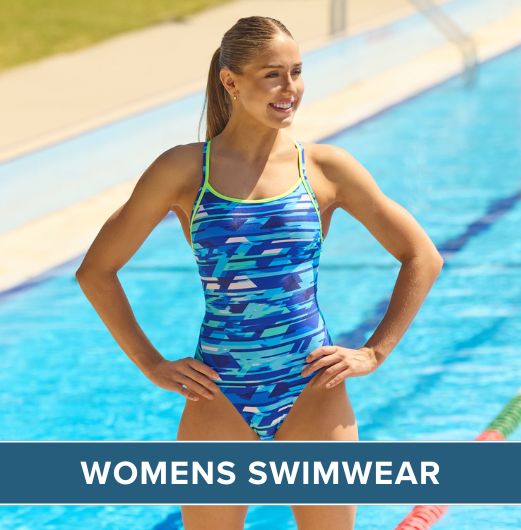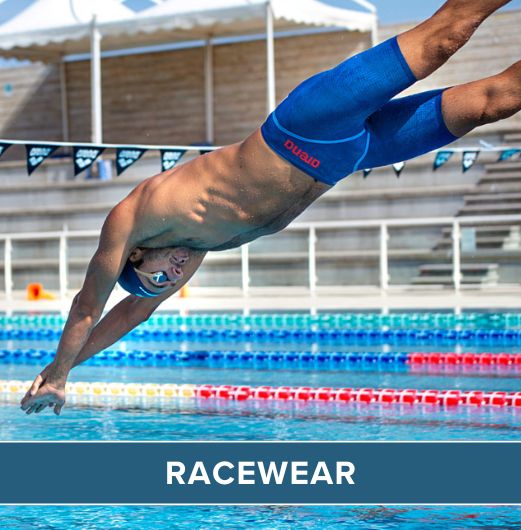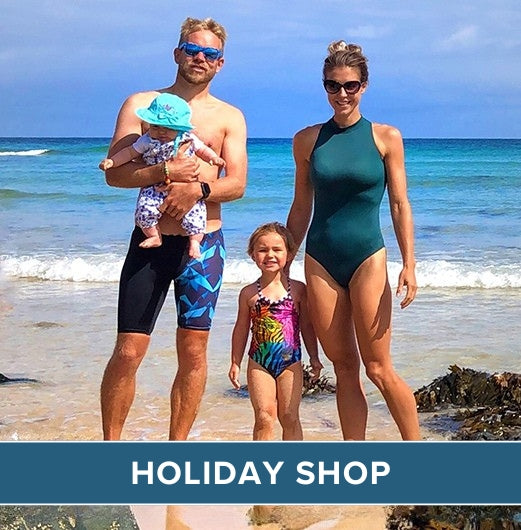Hello, I'm Victoria from Puddle Ducks. We teach babies and children across the U.K. to swim and we're here with Simply Swim today to talk you through some advice videos.
Getting In
I'm going to talk you through safe entry into the water today for your baby. Firstly, what you need to remember is that you don't ever carry a baby down steps or a down a ladder into the water. The reason for this is if you slip, you're going to take your baby with you, which we don't recommend at all. What we do recommend is a changing mat, which you can get wet. So you get the changing mat wet in the water first and then lay it on the side of the pool right next to the surface of the water. You can then kneel down and lay your baby flat on that changing mat so it's nice and warm. This stops them going straight onto the cold concrete on the side of the pool, which isn't a great introduction to their first lesson into the water.
When you're laying your baby down on the mat, ensure that their feet are pointing towards the water with their head the other way. You can then sit down next to them. You put one arm across your baby. This is your safety arm. This is to stop your baby rolling either side and ensures that it's safer for them before they get into the water and ensure they can't roll into the water on their own.
Once you've got the safety arm across your baby, you can then gently slide into the water yourself, turning as you do so. Once you're in the water, you then put both of your hands behind your baby's head and neck to make sure that's fully supported. In your own time, gently lean your baby towards you and bring them in towards the water, safely. This is a much more controlled way of taking your baby into the water, rather than carrying them down the steps.
If you are going swimming with somebody else, they can help you by putting their arms across the baby on the change mat. What we don't recommend is that other person passes the baby to you in the water, and passes them across the air. This is also because if they slip or if they drop the baby, that's quite a long way for them to fall. So, it's much safer to lay that baby down on the mat and bring them into the water safely.
Swings and Dips
Swings and dips is an activity that encourages your baby to spend a little bit of time in the water flat on their back.
To start with, you swing your baby up in a seated position, always supporting their head and neck, and then gently rock them flat on the surface of the water. If your baby is happy flat on the water, then you would keep them there for as long as possible and then sit them up just a little bit. If your baby isn't too keen on being flat on the water on their back, then you can sit them up for a little bit longer, and then gently rock them flat on their back to give them a few seconds in this position, and then sit them back up again.
When your baby is flat on the water, it gives them a chance to have their ears in the water and get used to that pressure change and what it feels like to have water going in their ears before you sit them back up again. It's a really fun activity and a great way for you to bond with your baby, so lots of smiley faces, lots of eye contact. Try and make it as fun as possible.
Breathing
We're going to talk through breathing activities and why it's important to teach breathing activities from a young age.
As early as possible, we introduce these activities to encourage your baby to learn when they're swimming to breathe in above the water and breathe out under the water, which is a very natural way of swimming. You support your baby's head with two hands behind their head and neck and bring them in towards you, sitting them up a little bit. Breathe in above the water, and then gently blow bubbles into the water. Your baby won't be copying you yet, but they will be watching and learning and when they're a bit older, they'll want to start copying you.
If your baby does have good head and neck control, then you can go to a slightly more supported hold either side of their tummy, which is one hand either side of their tummy, nice relaxed hold, and again practice those bubbles. Breathe in above the water and breathe out under the water. Make it really fun and in a little while your baby will start to copy you.

Kicking
We're going to explain how you can help your baby start to learn how to kick their legs in the water. Always need to make sure that their head and neck is supported. You can bring their head in toward your chest a little bit more. Or if not, keep them high up on your shoulder so you know that their mouth is clear of the water. You can use your hand or hands to help them kick their legs, depending on how you're supporting their head and neck. This will eventually lead to them learning how to use that propulsion in the water by kicking their legs.
You can do lots of games or sing lots of songs in the water to keep them entertained whilst you're practising kicking their legs. Builds up the muscles in their legs and through their spine as well, so you can help them either side of their legs using your hands to help them kick those legs whilst they're in the water. All of these activities are really good for strengthening muscles and helping them learn how to push themselves forwards in the water.
Splashing Hands
We're going to talk about splashing hands in the water when you're swimming with your baby. Splashing hands is obviously a really fun thing to do. Firstly, it get little bits of water flicking up onto your baby's face, which if they start to learn that from a very young age, they'll understand that that's very normal and if they're going swimming, they will get bits of water in their face and they'll learn that that's very normal when they do go swimming with you.
You can help them to start with so you can support them with one arm across their tummy and chest and use your spare hand to help them splash their hands in the water. If they're not too keen on it, then you can let go of that hand that's helping them splash their hands and do it for them. Splash next to them so they get a feel of what it's like and then as they get a bit older or maybe a bit later on, they might then want to help and you can hold their hand and help them splash again.
It's a really, really fun activity and arm movements in the water do lead to paddling and then obviously onto swimming on their front, pulling that water behind them.
Walk-Floating
We're going to talk you through walk-floating now and this walk-floating will be with your baby on their tummy. This is for babies that are a lot more wriggly and often don't like being on their back anymore or it's unsafe for them to be on their back.
We need to make sure that we have a light hand supporting either side of their tummy and your thumbs can be in a "V" position to start with. This is to support their head and neck a little bit and if their chin starts to drop, your hands are there to support them. You still move backwards so that your baby is going forwards and their head is going first. It's a really good chance for you to have a bonding experience with your baby and to give that good eye-to-eye contact. Lots and lots of smiley faces to encourage your baby to stay relaxed in the water.
You can gently move them side to side to get them used to that water moving across their body. If they're still very relaxed and if they've got very good head and neck control, you can then go to a bit more of a relaxed hold. This is where you tuck your thumbs underneath the shoulders of your baby and your hands are flat underneath their tummy. You can position your hands slightly pointing upwards a little bit to encourage their chin and their mouth to be above the water. You're still moving backwards and your baby is still going forwards, but this position gives them a lot more freedom in the water. Again, nice relaxed hands and you can gently sway them side to side as well if they want to feel that water moving a little bit more.
We're going to talk you through walk-floating now, and we're going to start with walk-floating on your baby's back. So the important thing to remember is that to start with, you always support your baby's head and neck and you also support underneath their seat. This is so that it's not too much strain on their back.
When we're practising walk-floating on the baby's back, it's to encourage that movement of water across their body and to get them used to what it feels like to be moving in water. When you do start to move and your baby has got a bit of momentum in the water, you can then release that hand that's underneath their seat. This gives them a lot more independence and a lot more freedom in the water to feel that water moving.
All the time that you're moving backwards and your baby's head is going first, you can just keep that one hand underneath their head and neck. This is because the water is supporting the back of their body and their seat and their legs. Their muscles in their legs are much denser, generally, than the fat that is in their tummy and their arms. So all the time that you're moving, it's fine to keep that one hand underneath their head and neck. However, if you stop moving at any point, you must put that hand back underneath their seat. If you don't, it can cause their legs to sink a bit in the water and it puts a lot of strain on their neck.
Cheek Support
If your baby is starting to move a bit more or you'd like to give them a little bit more independence, but they're still happy on their back, we then go to what's called a cheek support, which is two hands either side of their cheek. Again, all the time you're moving this is fine. But if you stop, you need to go back to supporting underneath their seat again.
We keep babies on their back for as long as possible. Firstly, it's a good survival skill to learn how to float in the water and how to keep their mouth above the water, but it's also very good for their alignment when they're swimming. It's much easier to teach a flat, natural swim alignment with a baby on their back than it is if a baby is on their tummy.
Getting Out
We're going to talk through a safe exit out of the water now when you're swimming with your baby.
Again, the same as when you get a baby into the water, we would recommend that you use a change mat and get it wet so it's nice and warm, and lay that flat next to the pool. If you're swimming on your own and the free board is quite low, so the free board is the edge of the pool in comparison to the edge of the water, so if there's not much difference there, you can lay your baby on that change mat, again with their feet pointing towards the water. You then put one arm across your baby and climb out onto the side of the pool next to your baby. The reason why we recommend that you keep that arm across your baby at all times is because if they do roll, your arm is there to stop them rolling into the water. If the free board is very high and there are integrated steps in the water like there is at this pool here, we can lay the mat as close to the steps as possible. Again, you lay your baby on this change mat in the same way as before, so their feet are pointing towards the water.
You can then start to walk out of the steps, keeping your arms either side. And then when you feel it's safe to do so, you can climb out on the side of the pool next to your baby.
If you're lucky enough to be going swimming with somebody else that can help you, then one of you can get out of the water first, and go around next to the change mat. And the other person can gently lay their baby on that warm change mat, again with their feet pointing towards the water. You can keep your arms either side of your baby whilst the other person then takes the baby from the mat up into the air as normal.
That then gives you a chance to get out of the water without having to worry about carrying them out of a ladder or steps and slipping and possibly taking your baby with you. This is a much safer way to get out of the pool.
Shop Maternity or Baby and Toddler Swimwear
 Free Tracked UK Delivery
Free Tracked UK Delivery Hassle Free Returns
Hassle Free Returns Next Working Day OPTION
Next Working Day OPTION Found It Cheaper?
Found It Cheaper?














